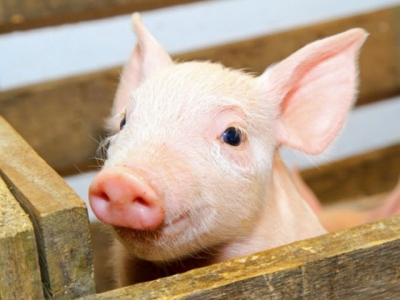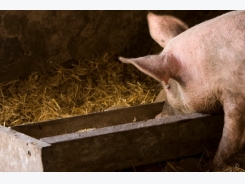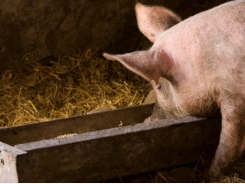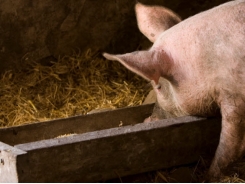Protein amount, not source may guide antibiotic-free swine production

In antibiotic-free diets, the level of crude protein used may aid piglet growth and support gut health, than the actual protein type, say Chinese researchers.
Results published in Animal Nutrition tracked the growth, average daily gain, gut health and diarrhea incidents of piglets raised on antibiotic-free diets that included different levels of crude protein (CP) from either soy protein concentrate (SPC) or fishmeal (FM), researchers said.
The group sought to evaluate the influence protein amounts and sources have on piglets.
“Previous investigations have shown the possible associations between the incidences of diarrhea of piglets and dietary CP sources as well as levels, they said. “However, few have examined the effects of different protein sources and levels on growth performance and intestinal health of piglets fed antibiotics-free diets.”
Without antibiotics in feed, the lower protein diet 17% had a positive effect on growth and incidents of diarrhea, researchers said. “Dietary CP level, rather than its source (either fish meal or soy protein concentrate), has more significant impacts on the growth performance and intestinal health of 21 to 35 d-old weaned piglets when fed antibiotics-free diets,” they added.
Antibiotic-free feed
In-feed antibiotics have been used in piglet weaning diets to prevent gut disorders including diarrhea, mucosal inflammation and intestinal barrier dysfunction, said the researchers. However, increasing concerns about antibiotics and bans on use for disease prevention mean that producers need to find alternative methods of controlling diarrhea and post-weaning gut health, they said.
In diets with antibiotics, low-protein feeds have been shown to benefit intestinal health and fecal consistency, researchers said. But growth needs have been better served with diets including 19-23% CP and those using animal-based protein sources instead of plant-based protein.
“This study investigated the effects of dietary CP levels (17%, 19%, and 23.7%) and protein sources on the growth performance and intestinal health in weaned piglets without feeding any antibiotic growth promoters,” they said.
Experiment details
In the study, 150 male piglets were given one of five dietary treatments seeking to alter the protein sources and amounts, said researchers. Water and feed were provided ad libitum throughout the two-week feeding experiment.
The diets included a control (17% CP) containing 62% corn, 17.5% soybean meal and 3% fish meal; a corn-soy diet with added soy protein concentrate (SPC) or fish meal (FM) to reach 19% CP; and the corn-soy diet with 23.7% CP from either added FM of SPC, they said.
Daily feed intake was recorded along with piglet beginning and ending weights, they said. Fecal matter consistency was recorded daily and both the intestinal tract and digesta were collected at the end of the experiment from a sample of piglets.
Results
The ending body weights for piglets in the control group and getting the 19% FM CP diet were similar, while all other groups weighed less, said the scientists. The average body weight for control group piglets was 7.48 kg and those getting the fish meal diet were 6.73 kg.
All groups had similar average daily feed intake, they added.
The control group had an average daily gain of 107g, higher than those getting either level of SPC or FM, researchers said. And the control group had the least diarrhea as its occurrence increased linearly with the protein amount.
The control group had more villous height in the duodenum and the jejunum, but less crypt depth, they said. The villous height to crypt depth ratio was increased compared to the control group, except for piglets getting the 23% FM diet, that group had a lower ratio than the 19% FM diet.
“Compared to control group, the expression of inflammatory cytokines interleukin-1β (IL-1β) and interferon-γ (IFN-γ) were increased in the jejunum and colon of piglets, as did cystic fibrosis transmembrane conductance regulators (CFTR) in the distal colon,” they said. “The relative transcript abundance of Zonula occludens-1 (ZO-1) in the jejunum, and occludin in the jejunum and ileum of piglets fed 23.7% CP diets were reduced compared with those fed control diet.”
The lack of performance from piglets getting higher levels of CP in their diets may indicate poorer gut health stemming from effects including increased inflammation and more diarrhea, said the authors.
Title: Effects of protein sources and levels in antibiotic-free diets on diarrhea, intestinal morphology, and expression of tight junctions in weaned piglets
Có thể bạn quan tâm
Phần mềm

Phối trộn thức ăn chăn nuôi

Pha dung dịch thủy canh

Định mức cho tôm ăn

Phối trộn phân bón NPK

Xác định tỷ lệ tôm sống

Chuyển đổi đơn vị phân bón

Xác định công suất sục khí

Chuyển đổi đơn vị tôm

Tính diện tích nhà kính

Tính thể tích ao hồ




 Breeding and feeding interplay could make monogastric production…
Breeding and feeding interplay could make monogastric production…  Diet quality, supplement combinations, later weaning may boost…
Diet quality, supplement combinations, later weaning may boost…